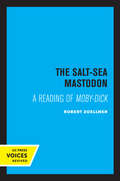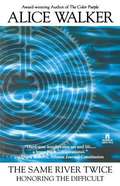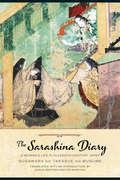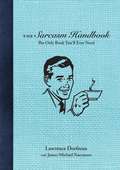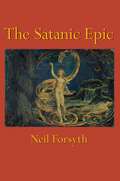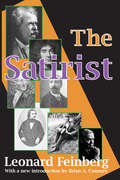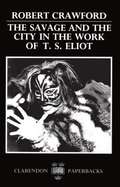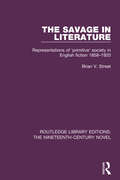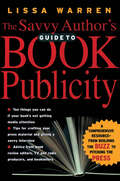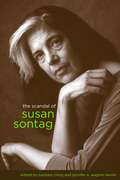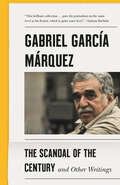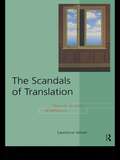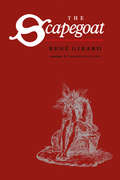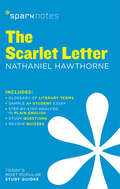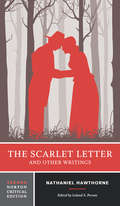- Table View
- List View
The Salt-Sea Mastodon: A Reading of Moby-Dick
by Robert ZoellnerThis title is part of UC Press's Voices Revived program, which commemorates University of California Press’s mission to seek out and cultivate the brightest minds and give them voice, reach, and impact. Drawing on a backlist dating to 1893, Voices Revived makes high-quality, peer-reviewed scholarship accessible once again using print-on-demand technology. This title was originally published in 1973.
The Same Moon Shines on All: The Lives and Selected Poems of Yanagawa Seigan and Kōran
by Yanagawa SeiganYanagawa Seigan (1789–1858) and his wife Kōran (1804–79) were two of the great poets of nineteenth-century Japan. They practiced the art of traditional Sinitic poetry—works written in literary Sinitic, or classical Chinese, a language of enduring importance far beyond China’s borders. Together, they led itinerant lives, traveling around Japan teaching poetry and selling calligraphy. Seigan established Edo-period Japan’s largest poetry society and attained nationwide renown as a literary figure, as well as taking part in stealthy political activities in the years before the Meiji Restoration. Kōran was one of the most accomplished female composers of Sinitic poetry in Japanese history. After her husband’s death, she was arrested and imprisoned for six months as part of a crackdown on political reform. Seigan and Kōran’s works at once display mastery of a poetic tradition and depict Japan on the brink of monumental change.The Same Moon Shines on All explores the world of Seigan and Kōran, pairing an in-depth account of their lives and times with an inviting selection of their poetry. The book features eminent Sinologist Jonathan Chaves’s translations of more than 130 poems by Seigan and more than 50 by Kōran, each annotated and followed by the original Chinese text. An introduction by Matthew Fraleigh, a specialist in Japan’s Sinitic literature, offers insight into the historical and literary context as well as the poems themselves. Approachable and delightful, this book makes the riches of Japanese Sinitic poetry available to a range of readers.
The Same River Twice: Honoring the Difficult
by Alice WalkerIn the early eighties, three extraordinary events interrupted Alice Walker's peaceful, reclusive life--the publication of the bestselling novel The Color Purple, the Pulitzer Prize, and an offer from Spielberg to make her novel into a film. This book chronicles that period of transition from recluse to public figure, and invites us to contemplate, along with her, the true significance of unanticipated gifts.
The Sandburg Treasury: Prose and Poetry for Young People
by Carl Sandburg Paul BaconAn illustrated volume of all of Carl Sandburg's books for young readers: Rootabaga Stories, Early Moon, Wind Song, Prairie-Town Boy, and Abe Lincoln Grows Up. Introduction by Paula Sandburg.
The Sarashina Diary: A Woman's Life in Eleventh-Century Japan (Reader's Edition) (Translations from the Asian Classics)
by Sugawara no Sugawara no Takasue no MusumeA thousand years ago, a young Japanese girl embarked on a journey from deep in the countryside of eastern Japan to the capital. Forty years later, with the long account of that journey as a foundation, the mature woman skillfully created an autobiography that incorporates many moments of heightened awareness from her long life. Married at age thirty-three, she identified herself as a reader and writer more than as a wife and mother; enthralled by fiction, she bore witness to the dangers of romantic fantasy as well as the enduring consolation of self-expression.This reader’s edition streamlines Sonja Arntzen and Moriyuki Itō’s acclaimed translation of the Sarashina Diary for general readers and classroom use. This translation captures the lyrical richness of the original text while revealing its subtle structure and ironic meaning, highlighting the author’s deep concern for Buddhist belief and practice and the juxtaposition of poetic passages and narrative prose. The translators’ commentary offers insight into the author’s family and world, as well as the style, structure, and textual history of her work.
The Sarashina Diary: A Woman's Life in Eleventh-Century Japan (Translations from the Asian Classics)
by Sugawara no Sugawara no Takasue no MusumeA thousand years ago, a young Japanese girl embarked on a journey from the wild East Country to the capital. She began a diary that she would continue to write for the next forty years and compile later in life, bringing lasting prestige to her family. Some aspects of the author's life and text seem curiously modern. She married at age thirty-three and identified herself as a reader and writer more than as a wife and mother. Enthralled by romantic fiction, she wrote extensively about the disillusioning blows that reality can deal to fantasy. The Sarashina Diary is a portrait of the writer as reader and an exploration of the power of reading to shape one's expectations and aspirations. As a person and an author, this writer presages the medieval era in Japan with her deep concern for Buddhist belief and practice. Her narrative's main thread follows a trajectory from youthful infatuation with romantic fantasy to the disillusionment of age and concern for the afterlife; yet, at the same time, many passages erase the dichotomy between literary illusion and spiritual truth. This new translation captures the lyrical richness of the original text while revealing its subtle structure and ironic meaning. The introduction highlights the poetry in the Sarashina Diary and the juxtaposition of poetic passages and narrative prose, which brings meta-meanings into play. The translators' commentary offers insight into the author's family and world, as well as the fascinating textual legacy of her work.
The Sarcasm Handbook
by Lawrence Dorfman James Michael NaccaratoFrom the author of the bestselling Snark series comes the premiere guide to satire, sneering, jeering, and mockery in their finest forms. A surviving knight of many a verbal joust, Larry Dorfman has become an expert at backhanded sass and cathartic banter.Featuring life lessons from the master himself, as well as quotes and quips by some of history’s sarcastic greats, The Sarcasm Handbook teaches readers how to deflect stupidity and express their inner dissatisfaction with a keen sensibility, hushing subtlety, and wisecrack wit. Included in these invaluable teachings are chapters on achieving the right tone, sarcastic bastards in history, as well as scenarios depicting some of the greatest moments in sarcasm.So pick up your copy today and start learning the art of disparagement through passive aggressiveness!
The Satanic Epic
by Neil ForsythThe Satan of Paradise Lost has fascinated generations of readers. This book attempts to explain how and why Milton's Satan is so seductive. It reasserts the importance of Satan against those who would minimize the poem's sympathy for the devil and thereby make Milton orthodox. Neil Forsyth argues that William Blake got it right when he called Milton a true poet because he was "of the Devils party" even though he set out "to justify the ways of God to men." In seeking to learn why Satan is so alluring, Forsyth ranges over diverse topics--from the origins of evil and the relevance of witchcraft to the status of the poetic narrator, the epic tradition, the nature of love between the sexes, and seventeenth-century astronomy. He considers each of these as Milton introduces them: as Satanic subjects. Satan emerges as the main challenge to Christian belief. It is Satan who questions and wonders and denounces. He is the great doubter who gives voice to many of the arguments that Christianity has provoked from within and without. And by rooting his Satanic reading of Paradise Lost in Biblical and other sources, Forsyth retrieves not only an attractive and heroic Satan but a Milton whose heretical energies are embodied in a Satanic character with a life of his own.
The Satirist: His Temperament, Motivation, And Influence
by Theodore DraperSatire takes as its subject the absurdity of human beings, their societies, and the institutions they create. For centuries, satirists themselves, scholars, critics, and psychologists have speculated about the satirist's reasons for writing, temperament, and place in society. The conclusions they have reached are sometimes contradictory, sometimes complementary, sometimes outlandish. In this volume, Leonard Feinberg brings together the major theories about the satirist, to provide in one book a summary of the problems that specialists have examined intensively in numerous books and articles.In part 1, Feinberg examines the major theories about the motivation of the satirist, and then proposes that "adjustment" comes most closely to answering this question. In his view, the satirist resolves his ambivalent relation to society through a playfully critical distortion of the familiar. The personality of the satirist, the apparently paradoxical elements of his nature, the problem of why so many great humorists are sad men, and the contributions of psychoanalysts are explored in part 2, where Feinberg contends that the satirist is not as abnormal as he has sometimes been made to seem, and that if he is a neurotic he shares traits of emotional or social alienation with many others. Part 3 explores the beliefs of satirists and their relation to the environment within which they function, particularly in the contexts of politics, religion, and philosophy. Feinberg stresses the ubiquity of the satirist and suggests that there are a great many people with satiric temperaments who fail to attain literary expression.Ranging with astonishing breadth, both historical and geographical, The Satirist serves as both an introduction to the subject and an essential volume for scholars. Brian A. Connery's introduction provides an overview of Feinberg's career and situates the volume in the intellectual currents in which it was written.
The Satthianadhan Family Album
by Eunice De SouzaMiscellaneous writings of the members of the Satthianadhan family, edited by Eunice de Souza.
The Satyricon: the Apocolocyntosis
by Seneca PetroniusPerhaps the strangest - and most strikingly modern - work to survive from the ancient world, The Satyricon relates the hilarious mock epic adventures of the impotent Encolpius, and his struggle to regain virility. Here Petronius brilliantly brings to life the courtesans, legacy-hunters, pompous professors and dissolute priestesses of the age - and, above all, Trimalchio, the archetypal self-made millionaire whose pretentious vulgarity on an insanely grand scale makes him one of the great comic characters in literature. Seneca's The Apocolocyntosis, a malicious skit on 'the deification of Claudius the Clod', was designed by the author to ingratiate himself with Nero, who was Claudius' successor. Together, the two provide a powerful insight into a darkly fascinating period of Roman history.
The Savage And The City In The Work Of T. S. Eliot (Oxford English Monographs)
by Robert CrawfordThe twin concerns of primitive and metropolitan life nourished T.S. Eliot's imagination through his childhood and student years and developed to mould and underpin his writing. Ranging from Dr Sweany of St Louis and Eliot's intense interest in anthropology to his interest in Victorian urbanwriting and popular American models, this book throws new light on Eliot's major works, particularly on The Waste Land and Sweeney Agonistes. In understanding how a great poet obsessively and continually brought together `savages' and the sophisticated as well as slum-dwelling members of modernurban society, we can see his work afresh as possessing remarkable and profound excitement as well as unusual integrity.
The Savage Detectives Reread (Rereadings)
by David KurnickThe Savage Detectives elicits mixed feelings. An instant classic in the Spanish-speaking world upon its 1998 publication, a critical and commercial smash on its 2007 translation into English, Roberto Bolaño’s novel has also been called an exercise in 1970s nostalgia, an escapist fantasy of a romanticized Latin America, and a publicity event propped up by the myth of the bad-boy artist.David Kurnick argues that the controversies surrounding Bolaño’s life and work have obscured his achievements—and that The Savage Detectives is still underappreciated for the subtlety and vitality of its portrait of collective life. Kurnick explores The Savage Detectives as an epic of social structure and its decomposition, a novel that restlessly moves between the big configurations—of states, continents, and generations—and the everyday stuff—parties, jobs, moods, sex, conversation—of which they’re made. For Kurnick, Bolaño’s book is a necromantic invocation of life in history, one that demands surrender as much as analysis.Kurnick alternates literary-critical arguments with explorations of the novel’s microclimates and neighborhoods—the little atmospheric zones where some of Bolaño’s most interesting rethinking of sexuality, politics, and literature takes place. He also claims that The Savage Detectives holds particular interest for U.S. readers: not because it panders to them but because it heralds the exhilarating prospect of a world in which American culture has lost its presumptive centrality.
The Savage and Modern Self: North American Indians in Eighteenth-Century British Literature and Culture
by Robbie RichardsonThe Savage and Modern Self examines the representations of North American "Indians" in novels, poetry, plays, and material culture from eighteenth-century Britain. Author Robbie Richardson argues that depictions of "Indians" in British literature were used to critique and articulate evolving ideas about consumerism, colonialism, "Britishness," and, ultimately, the "modern self" over the course of the century. Considering the ways in which British writers represented contact between Britons and "Indians," both at home and abroad, the author shows how these sites of contact moved from a self-affirmation of British authority earlier in the century, to a mutual corruption, to a desire to appropriate perceived traits of "Indianess." Looking at texts exclusively produced in Britain, The Savage and Modern Self reveals that "the modern" finds definition through imagined scenes of cultural contact. By the end of the century, Richardson concludes, the hybrid Indian-Brition emerging in literature and visual culture exemplifies a form of modern, British masculinity.
The Savage in Literature: Representations of 'primitive' society in English fiction 1858-1920 (Routledge Library Editions: The Nineteenth-Century Novel #37)
by Brian V. StreetFirst published in 1975, this study is concerned with the representation of non-European people in English popular fiction in the period from 1858-1920. It examines the developments in thinking about people across the world and shows how they affected writers’ views of evolution, race, heredity and of the life of the so-called ‘primitive’ man. This book will be of interest to those studying 19th century literature.
The Savvy Author's Guide to Book Publicity: A Comprehensive Resource--From Building the Buzz to Pitching the Press
by Lissa WarrenHere is an essential reference for writersufrom the self-published to those published by major housesuwritten by a leading book publicist who pitches books to media every day of her working life. Tapping into her years publicizing such authors as pediatrician Dr. T. Berry Brazelton, poet Mary Oliver, and economist John Kenneth Galbraith, Da Capo Press Senior Director of Publicity Lissa Warren covers book promotion with a publicist, without a publicist, and when a publicist isnOCOt getting results. Each chapter details what happens to a book once itOCOs off press, and how authors can be helpful in the promotion processuor even spearhead it if need beuto get the coverage they deserve. WarrenOCOs advice is buttressed by her stories of authorsuthe enterprising, the shy, the well-prepared, and the noviceurelating tours gone awry, best-sellers made and nearly made, and great and not-so-great author/publicist collaboration. The Savvy AuthorOCOs Guide to Book Publicity covers everything from how to write press material, targeting the right shows and publications, following up effectively with the media, and hiring people who can help ensure that every bookseller and consumer has a chance to hear an authorOCOs message loud and clear. "
The Scaffolding of Sovereignty: Global and Aesthetic Perspectives on the History of a Concept (Columbia Studies in Political Thought / Political History)
by Stefanos Geroulanos Zvi Ben-Dor Benite Nicole JerrWhat is sovereignty? Often taken for granted or seen as the ideology of European states vying for supremacy and conquest, the concept of sovereignty remains underexamined both in the history of its practices and in its aesthetic and intellectual underpinnings. Using global intellectual history as a bridge between approaches, periods, and areas, The Scaffolding of Sovereignty deploys a comparative and theoretically rich conception of sovereignty to reconsider the different schemes on which it has been based or renewed, the public stages on which it is erected or destroyed, and the images and ideas on which it rests.The essays in The Scaffolding of Sovereignty reveal that sovereignty has always been supported, complemented, and enforced by a complex aesthetic and intellectual scaffolding. This collection takes a multidisciplinary approach to investigating the concept on a global scale, ranging from an account of a Manchu emperor building a mosque to a discussion of the continuing power of Lenin’s corpse, from an analysis of the death of kings in classical Greek tragedy to an exploration of the imagery of “the people” in the Age of Revolutions. Across seventeen chapters that closely study specific historical regimes and conflicts, the book’s contributors examine intersections of authority, power, theatricality, science and medicine, jurisdiction, rulership, human rights, scholarship, religious and popular ideas, and international legal thought that support or undermine different instances of sovereign power and its representations.
The Scandal of Susan Sontag (Gender and Culture Series)
by Barbara Ching Jennifer Wagner-LawlorSusan Sontag (1933–2004) spoke of the promiscuity of art and literature-the willingness of great artists and writers to scandalize their spectators through critical frankness, complexity, and beauty. Sontag's life and thought were no less promiscuous. She wrote deeply and engagingly about a range of subjects-theater, sex, politics, novels, torture, and illness-and courted celebrity and controversy both publicly and privately. Throughout her career, she not only earned adulation but also provoked scorn. Her living was the embodiment of scandal.In this collection, Terry Castle, Nancy K. Miller, Wayne Koestenbaum, E. Ann Kaplan, and other leading scholars revisit Sontag's groundbreaking life and work. Against Interpretation, "Notes on Camp," Letter from Hanoi, On Photography, Illness as Metaphor, I, Etcetera, and The Volcano Lover-these works form the center of essays no less passionate and imaginative than Sontag herself. Debating questions raised by the thinker's own images and identities, including her sexuality, these works question Sontag's status as a female intellectual and her parallel interest in ambitious and prophetic fictional women; her ambivalence toward popular culture; and her personal and professional "scandals." Paired with rare photographs and illustrations, this timely anthology expands our understanding of Sontag's images and power.
The Scandal of the Century: And Other Writings (Vintage International Ser.)
by Gabriel García Márquez“The articles and columns in The Scandal of the Century demonstrate that his forthright, lightly ironical voice just seemed to be there, right from the start. . . . He’s among those rare great fiction writers whose ancillary work is almost always worth finding. . . . He had a way of connecting the souls in all his writing, fiction and nonfiction, to the melancholy static of the universe.” --Dwight Garner, The New York TimesFrom one of the titans of twentieth-century literature, collected here for the first time: a selection of his journalism from the late 1940s to the mid-1980s--work that he considered even more important to his legacy than his universally acclaimed works of fiction. "I don't want to be remembered for One Hundred Years of Solitude or for the Nobel Prize but rather for my journalism," Gabriel García Márquez said in the final years of his life. And while some of his journalistic writings have been made available over the years, this is the first volume to gather a representative selection from across the first four decades of his career--years during which he worked as a full-time, often muckraking, and controversial journalist, even as he penned the fiction that would bring him the Nobel Prize in 1982. Here are the first pieces he wrote while working for newspapers in the coastal Colombian cities of Cartagena and Barranquilla . . . his longer, more fictionlike reportage from Paris and Rome . . . his monthly columns for Spain's El País. And while all the work points in style, wit, depth, and passion to his fiction, these fifty pieces are, more than anything, a revelation of the writer working at the profession he believed to be "the best in the world."
The Scandals of Translation: Towards an Ethics of Difference
by Lawrence VenutiTranslation is stigmatized as a form of writing, discouraged by copyright law, deprecated by the academy, exploited by publishers and corporations, governments and religious organizations.Lawrence Venuti exposes what he refers to as the 'scandals of translation' by looking at the relationship between translation and those bodies - corporations, governments, religious organizations, publishers - who need the work of the translator yet marginalize it when it threatens their cultural values.Venuti illustrates his arguments with a wealth of translations from The Bible, the works of Homer, Plato and Wittgenstein, Japanese and West African novels, advertisements and business journalism.
The Scapegoat
by René GirardWidely regarded as one of the most profound critics of our time, René Girard has pursued a powerful line of inquiry across the fields of the humanities and the social sciences. His theories, which the French press has termed "l'hypothèse girardienne," have sparked interdisciplinary, even international, controversy. In The Scapegoat, Girard applies his approach to "texts of persecution," documents that recount phenomena of collective violence from the standpoint of the persecutor—documents such as the medieval poet Guillaume de Machaut's Judgement of the King of Navarre, which blames the Jews for the Black Death and describes their mass murder.Girard compares persecution texts with myths, most notably with the myth of Oedipus, and finds strikingly similar themes and structures. Could myths regularly conceal texts of persecution? Girard's answers lies in a study of the Christian Passion, which represents the same central event, the same collective violence, found in all mythology, but which is read from the point of view of the innocent victim. The Passion text provides the model interpretation that has enabled Western culture to demystify its own violence—a demystification Girard now extends to mythology.Underlying Girard's daring textual hypothesis is a powerful theory of history and culture. Christ's rejection of all guilt breaks the mythic cycle of violence and the sacred. The scapegoat becomes the Lamb of God; "the foolish genesis of blood-stained idols and the false gods of superstition, politics, and ideologies" are revealed.
The Scarlet Letter (Case Studies in Contemporary Criticism)
by Nathaniel Hawthorne Ross C. MurfinThis volume presents the authoritative Centenary Edition text of Hawthorne's classic 1851 novel, along with critical essays that read The Scarlet Letter from contemporary reader-response, psychoanalytic, feminist, and new historicist perspectives. Three brief additional essays demonstrate how several critical perspectives can be combined. As in the first edition, the text and essays are complemented by biographical and critical introductions, bibliographies, and a glossary of critical and theoretical terms. Five of the seven essays are new to the second edition, as is a selection of cultural documents and illustrations.
The Scarlet Letter (MAXNotes Literature Guides)
by Michael PetrusREA's MAXnotes for Nathaniel Hawthorne's The Scarlet Letter The MAXnotes provides a comprehensive summary and analysis of The Scarlet Letter and a biography of Nathaniel Hawthorne. Places the events of the novel in historical context and discusses each chapter in detail. Includes study questions and answers along with topics for papers and sample outlines.
The Scarlet Letter SparkNotes Literature Guide (SparkNotes Literature Guide Series #57)
by SparkNotesThe Scarlet Letter SparkNotes Literature Guide by Nathaniel Hawthorne Making the reading experience fun! When a paper is due, and dreaded exams loom, here's the lit-crit help students need to succeed! SparkNotes Literature Guides make studying smarter, better, and faster. They provide chapter-by-chapter analysis; explanations of key themes, motifs, and symbols; a review quiz; and essay topics. Lively and accessible, SparkNotes is perfect for late-night studying and paper writing. Includes:An A+ Essay—an actual literary essay written about the Spark-ed book—to show students how a paper should be written.16 pages devoted to writing a literary essay including: a glossary of literary termsStep-by-step tutoring on how to write a literary essayA feature on how not to plagiarize
The Scarlet Letter and Other Writings (Norton Critical Editions #0)
by Nathaniel Hawthorne Leland S. PersonThis perennially popular Norton Critical Edition has been revised to reflect the most current scholarly approaches to The Scarlet Letter—Hawthorne’s most widely read novel—as well as to the five short prose works—“Mrs. Hutchinson,” “Endicott and the Red Cross,” “Young Goodman Brown,” “The Minister’s Black Veil,” and “The Birth-mark”—that closely relate to the 1850 novel. This Second Norton Critical Edition also includes: · Revised and expanded explanatory footnotes, a new preface, and a note on the text by Leland S. Person. · Key passages from Hawthorne’s notebooks and letters that suggest the close relationship between his private and public writings · Seven new critical essays by Brook Thomas, Michael Ryan, Thomas R. Mitchell, Jay Grossman, Jamie Barlowe, John Ronan, and John F. Birk. · A Chronology and revised and expanded Selected Bibliography.
